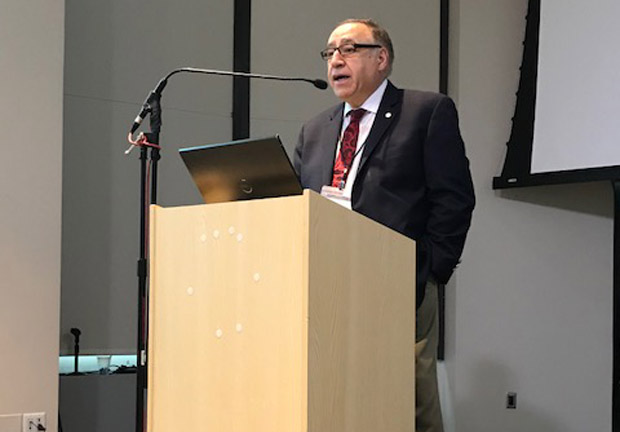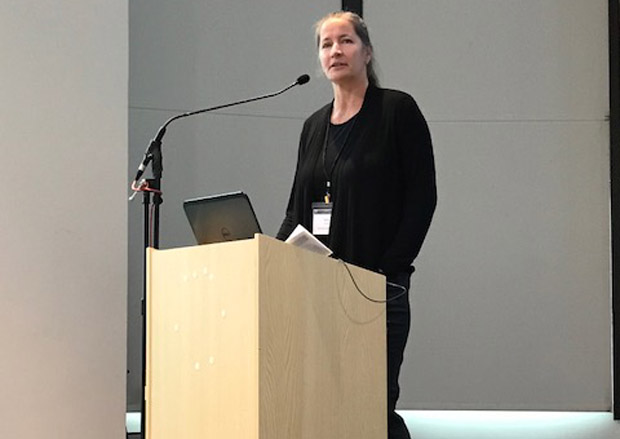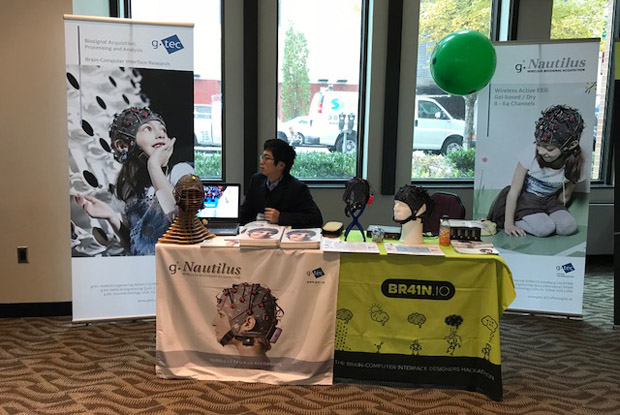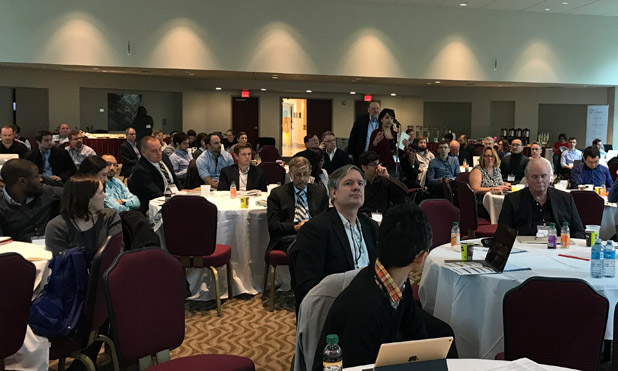Above: ANTBI workshop attendees gather for the session in Washington D.C.
Wherein lies the promise versus the hype, when discussing the latest in brain-related research and neurotechnology? Have we considered patient justice? Is actionable data actually available?
These are just a few of the big picture questions raised at the IEEE Brain Initiative Workshop on Advanced NeuroTechnologies for BRAIN Initiatives (ANTBI) held November 2017 in Washington D.C. The mission of the IEEE Brain Initiative is to facilitate cross-disciplinary collaboration and coordination, and this latest workshop was a testament to this endeavor in bringing together speakers from across the research spectrum. Workshop chair Metin Akay (below), University of Houston, and IEEE Brain Initiative Chair Paul Sajda, Columbia University, welcomed participants to join the conversation and share their thoughts on these key questions while interfacing with the broader community.

What’s clear from the research in recent years, we are on the cusp of a neurotechnology revolution, which has brought new and varied challenges to the table. With some relative success achieved in basic neural interfaces and rehabilitation, efforts are now focused on broader discussions of not only what’s next, but also what are the important objectives to consider at this precipice.
Keynote speaker Tim Denison, Vice President of Research and Core Technology, Medtronic, noted that as we move from Generation 1.0 in research device platforms—such as Deep Brain Stimulation (DBS)—toward Generation 2.0, i.e., functional replacements for the nervous system, we face many challenges. “Engineers have the opportunity to improve [systems] while reducing costs,” he noted, while emphasizing that all new technologies have to be made easy to use for patients. “Being empathetic to end users is critical,” he said, and engineers and researchers need to “work systematically to bring down risk.”
When it comes to future devices, Denison noted that it is imperative to consider the ability to upgrade, that is, developers must recognize that a continuous learning process is a loop rather than an end product. To this end, bringing in clinician feedback at different stages of development is also critical as researchers move forward, particularly working with clinicians to design effective algorithms and designing closed loop systems. “[Mapping algorithms] is going to be an interesting topic over the next years, ” he added. Ultimately, Denison urged the search for optimal outcomes with minimal clinical burden.
Finally, Denison highlighted an important question: What’s the impact of the therapy or the technology on the patient’s physiological state? Tracking neural signal information should provide actionable information for health and provide practical use for the patient. Gaining the trust of patients is key when we are working with the brain.
Ethical Inquiry
Perhaps unusual for a research event, a prominent portion of the workshop was devoted to discussion of neuroethics. Judy Illes, University of British Columbia, addressed the audience from a recorded message at the International Neuroethics Society meeting, reiterating the importance of language surrounding patient consent, and the ethical questions raised when we see an increase in the number of patents tied to brain research. Over the last decade, she noted, there has been a rise in ethical discussions surrounding neurotechnology, an encouraging sign that researchers and engineers acknowledge the larger context that surrounds their work.

Sara Goering, from the Department of Philosophy at the University of Washington (UW), shared some guiding principles of the work she has done with the UW Center for Sensorimotor Neural Engineering. Their goals include exploring ethical issues in connection to normative work in neurological areas, including what ought to be the correct approach, avoiding bias of researcher to product; and second, the norms surrounding ethical end user engagement, including the trade off between privacy and agency benefits. Regarding disability, Goering noted that “we see this as a problem to be solved,” but “the user may not want to be fixed.” When asked, many patients would prefer assistive technology versus the elimination of what is perceived as a disability. For example, there is a difference between efforts to cure deafness and those that provide assistive hearing and functioning devices; some may not see deafness solely as a liability. In this vein, Goering cautioned, it is important that those working in these areas “acknowledge neuro-diversity.”
Concurrently, any effort to design assistive technology requires what Goering termed “justice as recognition.” Inclusive of recognizing minority perspectives, the aim should be to do justice to the population we are trying to serve, and that means when technologies are being designed to benefit people with disabilities, people with disabilities need to be part of the early discussions and their input valued. Input from group discussions have shown that those with disabilities value technology assistance that could provide sensory restoration—touch is a key priority. Patients are also concerned about cost—will they be able to afford the technology as well as upkeep? Ultimately, they desire control over any data associated with the technology, wanting access along with the ability to delete sensitive data.
Of interest, Goering shared results from a deep brain stimulation (DBS) focus group that had been used to treat neurological complaints, including depression, in 2015. The device was unanimously perceived as helpful and even life saving, but the trial failed due to multiple feedback points regarding identity concerns. Patients perceived that the technology led to alienation of personal identity (who am I?) as well as relationship issues as the patient struggled to determine the line between themselves and the technology. Patients also struggled with issues of control and enhancement; those with depression didn’t trust themselves to maintain control of device, and they worried about a level of enhancement that caused them to feel happy all the time versus showing sadness when appropriate.
Ultimately, when developing technology that attempts to alter or work with brain function, researchers need to consider long-term responsibility: who will be responsible for this device or intervention for the rest of the patient’s life? Researchers must also keep top of mind patients’ worry about greater loss of function—when we are doing something with brain, what might be lost?
James Giordano, Chief of the Neuroethics Studies Program at Georgetown University, echoed these sentiments, further positing the question that when we have achieved the ability to access and affect neurological signals or to create devices that control or inhibit the brain, to what effect and end is this effort? Giordano emphasized that the utility of every device comes with multifold domains of use, and that when we agree upon the clinical or medical use, we are in effect defining “what is normal.” Conversely, we must also consider the context of use of the device or procedure beyond clinical: training and performance, military applications, public health and bio-hacking, as well as the global impact of medical tourism. He called for an international set of standards that would consider safety in practice, and address some of the far-ranging effects of research in this area, including effects upon cognition, emotion, and behavior.
Giordano further reiterated the importance of continuity with clinical care and research for patients. Only when this has been established should patient consent be requested. Distribution is a key issue tied to long-term maintenance, paired with simpler devices at lower costs. As we are dealing with transformative technology, Giordano advocated for a long-term perspective: researchers need to consider now rather than later how this technology will develop, knowing that end user input will likely change as they realize the possibility of any technology. He cautioned again that common perception holds the brain as integral to the essence of self, of consciousness, of what makes us individuals, so much so that the preservation of personal autonomy is paramount.
Technologies for Trauma and Injury
From a more technical perspective, Robert Kirsch, Case Western Reserve University, presented current research on a brain computer interface system (BCI) used to restore hand and arm function. Of particular note, in experiments the participant’s abilities varied between similar virtual and actual tasks. Kirsch noted that this is a key point to explore with virtual rehabilitation, in an effort to determine how the brain function changes between what the user perceives as a real function and that of a virtual simulation. He also argued that the next wave of BCI improvements should consider wireless designs for recording interfaces, longer-lasting intracortical implants for further stability in neural signals, more comprehensive and intelligent decoding algorithms, and an increase in the number and diversity of brain recordings.
Christoph Guger from Guger Technologies, Austria, shared information on his company’s motor-recovery neurotechnology products, including Nautilus and recoveriX, which is an external BCI system used for rehabilitation of arm movement after stroke. The product has shown to improve patient function over time, with 12-25 sessions leading to movement recovery. Guger also introduced mindBEAGLE, a consciousness assessment tool. The goal of the system is to determine if a person in a vegetative state understands questions; in working trials communication with the patient could be established 9 out of 12 times. The company is now working with coma patients in hopes of establishing connections, and further exploring brain plasticity.

Krishna Senoy, with the Neural Prosthetic Systems Lab (NPSL) at Stanford University, presented ground-breaking work using an intracortical brain-computer interface—BrainGate—that captures signals from the brain, which enabled users to communicate by moving a cursor on a keyboard in order to type. Jacob Robinson, Rice University, showcased work on an optical BCI, using light as an alternative to electrical brain-machine interfaces (BMIs). There is opportunity here to remove the normal interference that comes with electrical sensors by relying instead on integrated photonics; the challenges, however, lie in the miniaturization of optical systems, capturing high-speed imaging in scattering tissue, and data and power transmission. Further research in this area will include in vivo implementation and establishing limits for contrast resolution noise.
Mario Romero-Ortega, University of Texas, Dallas, showcased research on neuromodulation of small nerves and facial nerves, using soft conformal electrodes that apply a very small stimulation to nerves at acupuncture points, for example, to reduce hypertension. Jon Viventi, Duke University, presented the viability of flexible sensors that could be produced at much lower cost, yet could be used to record more localized events such as seizure points as the flexible polymer sensors could potentially provide high density sampling over multiple and irregular surfaces.
Rehabilitation Possibilities
What is memory? Is it possible to decode memories? These are questions posed by Ted Berger, University of Southern California, in an effort to develop a hippocampal prosthesis model to restore and/or enhance memory function. The hippocampus is responsible for creating new long-term memories from short-term memories. Loss of hippocampus-based memory due to diseases such as Alzheimer’s or epilepsy or trauma from stroke or head injury affects millions of patients each year at a cost of billions of dollars. The role of a hippocampal prosthesis would be to bypass damaged brain tissue with bio-mimetic cognitive function. Such an effort requires developing models for identifying and predicting memory codes; early trials have shown increase in short-term memory under specific conditions. Further efforts to decode memories are underway and could lead to greater understanding of memory function.
According to James Weiland, University of Michigan, the goal of the retinal prosthesis is not to restore sight but for users to gain more independence. “Visual acuity remains an issue, and patients are still legally blind,” he explains, but the effort “is really about outdoor mobility and a social connection to the world” for patients. Using computer vision software and computer vision algorithms that exist to map rooms, users are able to better navigate terrain by recognizing large objects, such as doors. The next phase of research will be moving forward with smaller electrodes in a pattern and more intense signals, and with efforts to make the current devices more functional.
Jack Judy, University of Florida, is investigating how best to target nerves with viable arrays in an effort to restore functionality. He notes that “arrays fail too frequently in penetrating probes, with a [simultaneous] loss of recording. Anyone developing neural technologies has to use an accelerated aging process to determine long term functionality.” Creating very small, 3D arrays that can connect to nerves at scale is a challenge. As Judy explains, “how do we get wet noodles into jello precisely”? His research efforts attempt to integrate the neural interface into a tissue-engineered scaffold, which is then inserted between the cut nerve in order to “try to engineer the environment where the interaction with our materials occurs.” Judy believes the use of such tissue-engineered scaffolds can overcome big challenges in nerve-interface technology and potentially contribute to nerve repair.
Research by Cynthia Chestek, University of Michigan, has led to unexpected outcomes for treating phantom limb pain. Her investigations into brain control of finger movement through peripheral nerve control have shown to prevent neuroma and peripheral phantom pain. The solution involves developing a regenerative peripheral nerve interface in the muscle by creating a muscle graft, suturing the nerve to it, and then wrapping the nerve in a “muscle taco”. This approach provides for large, stable recordings with intramuscular electrodes. In addition, putting the nerve into a muscle to make it bigger enables a more stable basis to insert an electrode, while closing off the nerve means it no longer tries to grow, one of the potential causes of phantom pain. Chestek notes that she is “now a convert to believing that peripheral nerves will be the solution” to restoring finger movement.
Silent Speech
What if you could type directly from your brain? One of the more anticipated speakers at the event was Mark Chevillet from Facebook. Chevillet proposed the creation of a silent speech interface for consumer applications. Such an effort does not come without significant challenges, however. Technical obstacles include decoding text from neural signals in real time, non-invasively; more elusive objectives would include defining something as nebulous as thought. “There’s a long way to go and problems to overcome but this isn’t science fiction anymore,” he stated. “To use this device you will have to imagine speaking; it needs to be effortful,” he added.
“Artificial speech recognition is a model for how this is effort is evolving; based on where we were in that field in the 1970s, this project has the same trajectory.”
Computational Challenges
According to Loren Frank from the Center for Integrative Neuroscience at University of California, San Francisco, “we fundamentally don’t understand how the brain works and we fundamentally don’t know how to fix it. What drives me is the basic science.” Frank’s particular interest is in the importance of memory. “As scientists and engineers, we actually do a lot to engender memories in ourselves and our colleagues’,” he noted. His research investigates the properties of awake memory, which engages both hippocampal and neocortical circuits that upon study appear to broadcast throughout the brain, that is, memory-related representations are distributed. Recognizing this, the challenge is how best to capture and make sense of the data. “Memory related activity patterns evolve on timescales from seconds to years,” he added.
In addition to understanding the complexities of memory, researchers like John White from Boston University are hoping to better understand intercellular communication in the hippocampus. “What sets the rhythm?” he asked. “What contributes to the period of quietness?” In an analogous computational challenge, Maryam Shanechi, from the University of Southern California, is attempting to decode the intricacies of mood. Efforts such as these set the stage for a range of new possibilities in the field of neuroscience, and pose yet further questions as to our knowledge of how the brain fundamentally works, and how we might someday make repairs.



